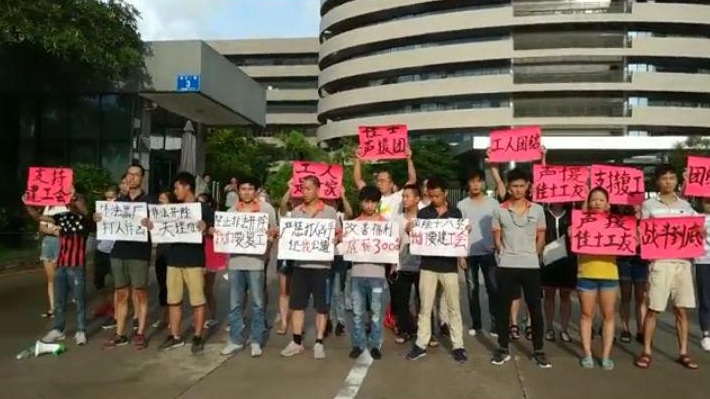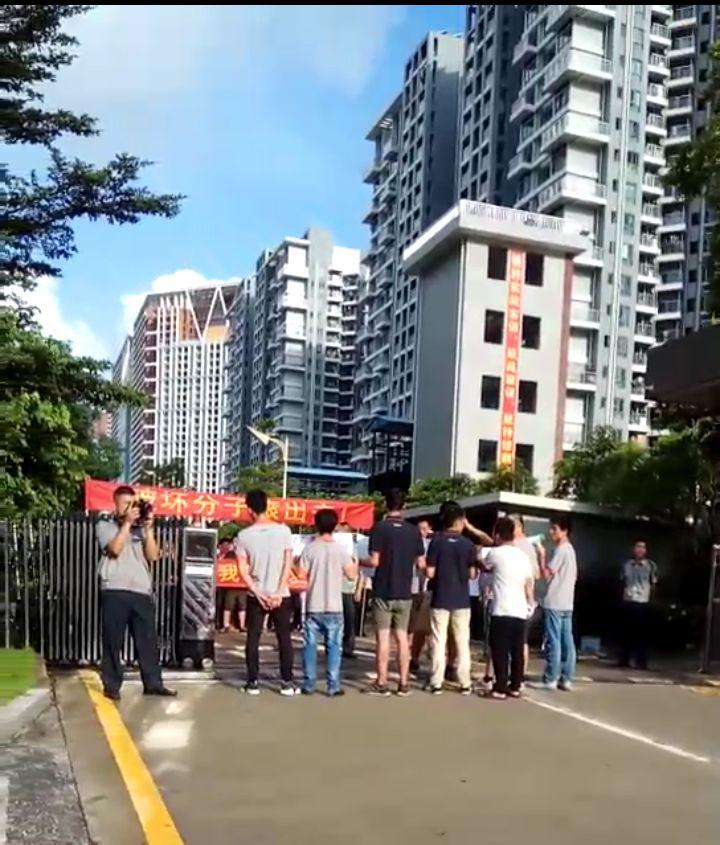by Brian Hioe
語言:
English
Photo Credit: 維權網
PROTESTS HAVE broken out in Shenzhen among workers for the Shenzhen Jasic Technology Corporation. Jasic workers sought to form a labor union, in accordance with rights they claim according to Chinese law, but were denied union representation by the company and by official, state-run labor unions.
At present, over twenty have been detained by police in the course of these protests, and possibly more than 30. Notably, the well-known Maoist labor activist, Shen Mengyu, was among those originally detained, but she was later released. Detained workers who were taken in on charges of causing public disturbances and “stirring up trouble” still remain unaccounted for. Workers have been detained since July 27th. This follows on the heels of worker firings on July 20th, apparently after clashes with police.
 Photo credit: 維權網
Photo credit: 維權網
Workers allege repressive actions by police, who have acted against workers and in the services of their employers. This has been through police either taking action against workers directly or failing to take any action when workers have been targeted by organized crime elements that appear to be acting on behest of their employers.
Although liberal, democracy activists are also reported to be involved in current labor activity among Jasic workers, the primary instigators are alleged to be Maoists organizers that entered the factory as workers. This includes Shen, known as a student-turned-organizer, who has been involved in a number of factory-based labor struggles in Guangzhou in past years, primarily as a elected union representative for car manufacturing factories that produce cars for companies including Honda and Nissan. Shen is currently involved in a lawsuit against NHK Spring, which fired her for her labor organizing.
In general, Guangdong has been a hotbed of labor activity in past years relative to other parts of China, particularly its capital of Guangzhou, and this would be the latest case in point. Guangdong has been involved in some of the multi-province strikes to hit China in past months, including a crane operators strike coordinated with May Day. Relatedly, preceding demonstrations by Jasic workers, earlier this month, mining workers from Hunan traveled to Shenzhen, Guangzhou, and other cities in Guangdong to protest that they had come down with black lung in the course of their work and their companies had little interest in compensating them or helping them with medical fees.
 Photo credit: 維權網
Photo credit: 維權網
The Xi administration has generally been tightening controls against all groups outside of the state which may be a source of potential dissidence, inclusive of liberal democracy activists, Maoists, feminists, and labor groups. Demonstrations in Guangdong take place in spite of that Guangdong has been particularly hard hit by government crackdowns.
Part of the Chinese party-state’s concern with Guangdong in particular seems to come from Guangdong’s proximity to Hong Kong, from which Chinese activists sometimes receive aid, or are able to outreach to the international world through. Despite that the Umbrella Movement in Hong Kong was not about Chinese social issues, but the deterioration of Hong Kong’s democratic freedoms under Chinese control, the Chinese government seems to be wary of waves of political dissent spreading from Hong Kong to China proper. This may not actually be a rational fear by China, given that it is actually quite unlikely for this to happen. Yet the Chinese government generally fears successive movements breaking out against it, along the lines of “color revolutions.”
Along such lines, the Chinese government more generally seems wary of disparate causes coming together in order to generate broader forms of dissent which might be expressed in the form of a social movement. For example, feminist activists have been among those to suggest that Chinese feminist activists should be paying attention to the plight of workers in the Jasic struggle.
 Photo credit: 維權網
Photo credit: 維權網
Similarly, increasing restrictions from the Chinese government may actually be in some cases forcing Maoists protesting the worker abuses of the Xi administration into the same boat as pro-western, liberal democracy activists with an interest in labor issues, just not from a Maoist worldview. The two groups have historically been opposed. Contemporary Chinese Maoists are divided, seeing as a large number of contemporary Chinese neo-Maoists are among the supporters of the current Xi administration while others are critical of it. Yet Maoists often see pro-western liberal democracy activists as potential traitors to the nation, and pro-western liberal democracy advocates argue for the abandonment of Maoist principles in favor of western models—inclusive of arguments for an unfettered free market, though not always the case. In the face of repression from the state against both, this may increasingly push them into the same boat.
Outbreaks of worker discontents such as the Jasic struggle or demonstrations by miners in Shenzhen are on the uptick in China, but it still remains to be seen whether such discontents will manage to find organization. Otherwise periodic outbreaks of protests will simply, in the end, be snuffed out by state repression.

